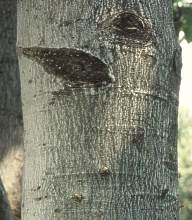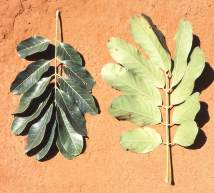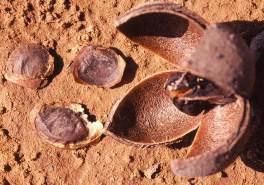Khaya anthotheca
Khaya anthotheca (Welw.) C.DC.
Family: Meliaceae
Common names: African Mahogany, East African Mahogany, Nyasaland Mahogany, Red Mahogany (Eng.); Oos-Afrikaanse mahonie (Afr.); Acaujo (French)
Introduction
This fairly fast growing tree — up to 1.5 m per year — is neat and decorative for larger gardens and parks in warm areas and is ideal for establishing shade and protection for other plants in the garden.

Description
Description
Khaya anthotheca is a large evergreen tree up to 60 m tall (up to 30 m in the garden) with an elongated or rounded, much-branched crown; the trunk is buttressed in old specimens. The bark on the young branches is smooth and greyish-brown but smooth to sometimes mottled grey and brown, flaking on the older branches and stems.

Leaves are alternate, evenly compound with 3-7 pairs of leaflets, 150-300 mm long and dark glossy green, base broadly tapering to round and slightly asymmetric, smooth and glossy, veins distinct on the lower surface, margin smooth.

Flowers appear in branched sprays at the tips of branches, are white and sweetly scented, up to 10 mm in diameter, the male and female flowers are separate but on the same tree, and the stamens join to form a tube up to 6 mm long. The flowering period is from September to December. The fruit is a hard, woody, oval, splitting capsule up to 60 mm in diameter, with 4 or 5 valves. Fruiting occurs from March to September.

Conservation Status
Status
According to the IUCN Red List of Threatened Species, Khaya anthotheca is assessed as Vulnerable (VU). Although this species is widespread in evergreen forests, it is an important source of timber that is heavily exploited, particularly in East and West Africa. Regeneration is poor in places, especially where parent trees are scarce, and serious genetic erosion is believed to have occurred. Some subpopulations are protected, and there are log export bans and felling limits in some countries.
Distribution and habitat
Distribution description
Khaya anthotheca occurs at medium to low altitudes in evergreen forests and riverine fringe forests in Africa. In Tanzania it is commonly found in the foothills of mountain ranges, in well-drained soils, and swamp and riverine areas. It has been successfully grown in the eastern parts of South Africa, and in Cuba and Puerto Rico.
Derivation of name and historical aspects
History
The Meliaceae is a large family of tropical timber trees that includes the true mahogany (Swietenia species), red mahogany (Khaya species) and sapele mahogany (Entandrophragma species), all world renowned for their excellent timber. Six genera of the mahogany family, namely Nymania, Turraea, Ekebergia, Trichilia, Pseudobersama and Entandrophragma, containing ten tree species, are indigenous to South Africa.
Khaya is one of four naturalized genera found in South Africa. The other three genera are Melia, Cedrela and Toona. The species name anthotheca is derived from the Greek word anthos (flower) and theke for the case/container of the flower.
Ecology
Ecology
Larvae of the white barred charaxes butterfly (Charaxes brutus natalensis) feed on the leaves of this tree.
Uses
Use
The wood of Khaya anthotheca weathers well and is resistant to borers and termites. It is moderately resistant to fungal decay. The timber saws well but is inclined to be tough, and sharp equipment is therefore needed. The wood is dark, hard, reddish brown and durable, suitable for furniture, flooring, panelling, and excellent for boat building, moderately heavy (air dry 620 kg/m 3 ), with an attractive grain. Khaya anthotheca is heavily used in the Ruvuma region of Tanzania for furniture. Large quantities of this species have been exported from East Africa.
The bark is bitter, similar to quinine, and is used for colds. Oil from the seed is rubbed into the scalp to kill insects.
Growing Khaya anthotheca
Grow
Khaya anthotheca grows easily from seed sown during spring. Soak the seeds in warm water to speed up germination. Plant seeds in seed trays filled with seedling soil or a mixture of river sand and sifted compost (1:1) and keep moist. Seeds germinate within 2-6 weeks. When they reach the two-leaf stage, transfer them into black nursery plastic bags. Transplant young trees when they reach a height of about ± 300 mm. Young trees are prone to damage from the shoot borer Tragocephala variagata.
References
- Burgess, N. & Clarke, G.P. 2000. Coastal forests of eastern Africa. The World Conservation Union, Cambridge.
- Estherhuyse, N., Von Breitenbach, J. & Sohnge, H. 2001. Remarkable trees of South Africa. Briza Publications, Pretoria.
- Immelman, W.F.E., Wicht, C.L. & Ackerman, D.P. 1973. The South African book of trees, our green heritage. Tafelberg, Cape Town.
- Leistner, O.A. (ed.). Seed plants of southern Africa : families and genera. Strelitzia 10. National Botanical Institute, Pretoria.
- Sutton, S.L., Whitmore, T.C. & Chadwick, A.C. 1983. Tropical rainforest: ecology and management. British Ecological Society, Oxford.
- Venter, F. & Venter, J.A. 1996. Making the most of indigenous trees. Briza Publications, Pretoria.
Credits
Alec Naidoo
Pretoria National Botanical Garden
September 2007
Acknowledgments: The author extends sincere thanks to colleagues who have rendered their invaluable advice and assistance.
Plant Attributes:
Plant Type: Tree
SA Distribution: KwaZulu-Natal, Limpopo, Mpumalanga
Soil type: Sandy
Flowering season: Spring, Early Summer
PH: Acid, Neutral
Flower colour: White
Aspect: Full Sun, Morning Sun (Semi Shade), Afternoon Sun (Semi Shade)
Gardening skill: Average
Special Features:
Horticultural zones









Rate this article
Article well written and informative
Rate this plant
Is this an interesting plant?
Login to add your Comment
Back to topNot registered yet? Click here to register.